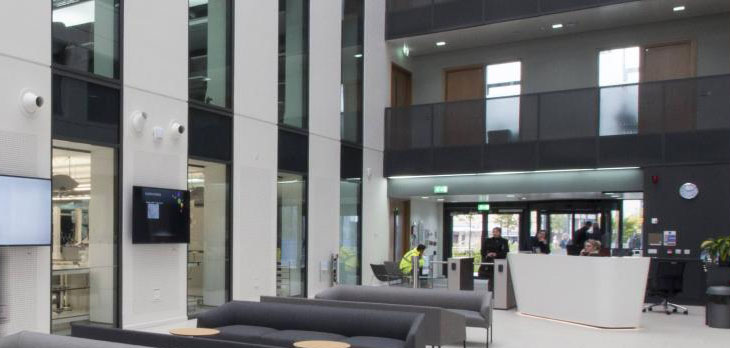The flex7 System, a range of lighting connection & control products manufactured by Flex Connectors Limited, was recently installed in the 4,530m² Discovery Centre at Dundee University. The new £26 million research building is a mix of research laboratories, office space and meetings rooms set over four storeys.
During the planning stages of the The Discovery Centre the university made the decision to install The flex7 System as an alternative to the more complex ‘front end systems’ employed elsewhere on the campus which were proving both costly and complicated to run.
Essential & Non-Essential Circuits
As the lighting circuits in the building were fed from Essential and Non-Essential distribution boards, flex7 Dual Supply Starter Units were identified as the ideal product to install. They are specifically designed to solve the common problem of how best to control two completely independent circuits with a single switching device. Dual Supply Starter Units are factory configured to suit their particular area of installation, resulting in each one having the required number of outlets shared accordingly between the two circuits.
In order to control the two circuits of connected luminaires seamlessly, Master & Slave Control Packs were plugged into either side of the Dual Supply Starter Unit and then linked via their network ports with a short plug-in network lead. This allowed a single wall mounted retractive switch, connected to one of the Control Packs via a plug-in switch drop, to afford on/off & regulating control of both circuits of luminaires simultaneously whilst operating at Protected Extra Low Voltage.
Occupancy control with corridor hold
Occupancy controls were also installed in conjunction with Corridor Hold Units which allowed luminaires in circulation areas to be held on while any adjacent room remained occupied, even if the circulation area itself was vacant. flex7 Corridor Hold Units are self-powered and are linked to other Control Packs via plug-in network leads. Each unit can accept inputs from up to eight individual areas, however if more inputs are required units can simply be linked together in order to accept signals from more areas.

In many buildings where energy-saving occupancy & absence sensors are installed, corridor lights can go off when the adjacent rooms and areas are still occupied. It is sometimes desirable – for safety or security reasons – for circulation luminaires to be held on until such time as the whole area has been vacated. The Corridor Hold Unit (fch8/2) provides the simplest of solutions to this problem. The main objective of the centre is to break down barriers between scientific disciplines to facilitate innovative discovery and translation. Construction began in July 2012, and It was officially opened on 1st October 2014.
 | Call Us: +44 (0)20 8580 1066 | sales@flex7.co.uk
| Call Us: +44 (0)20 8580 1066 | sales@flex7.co.uk
Leave A Comment